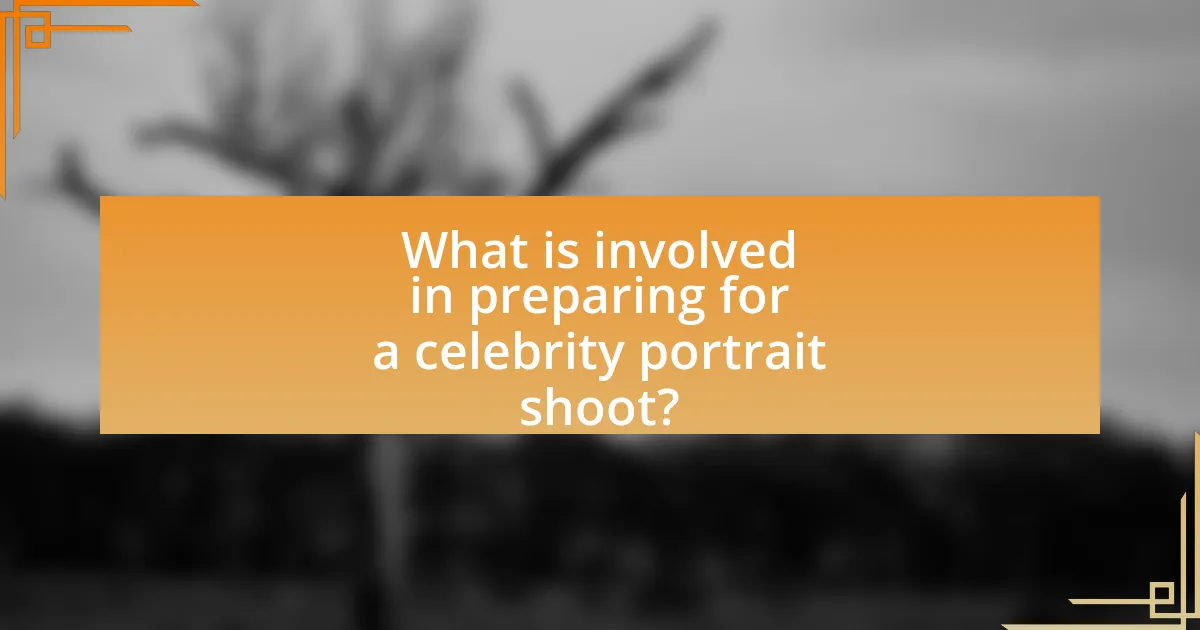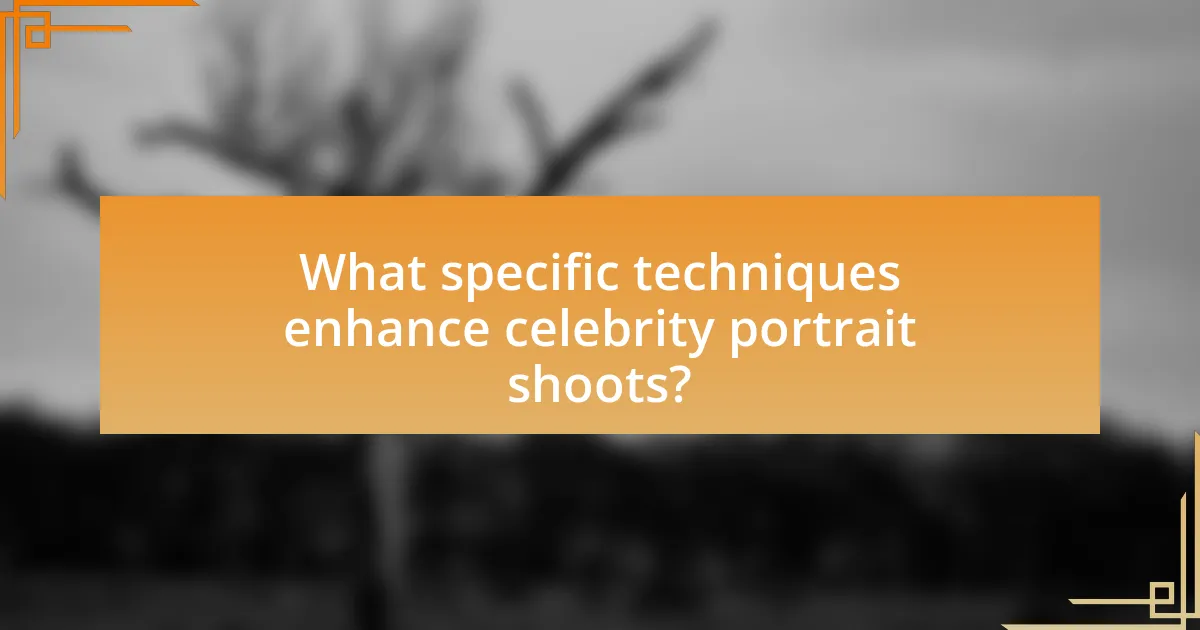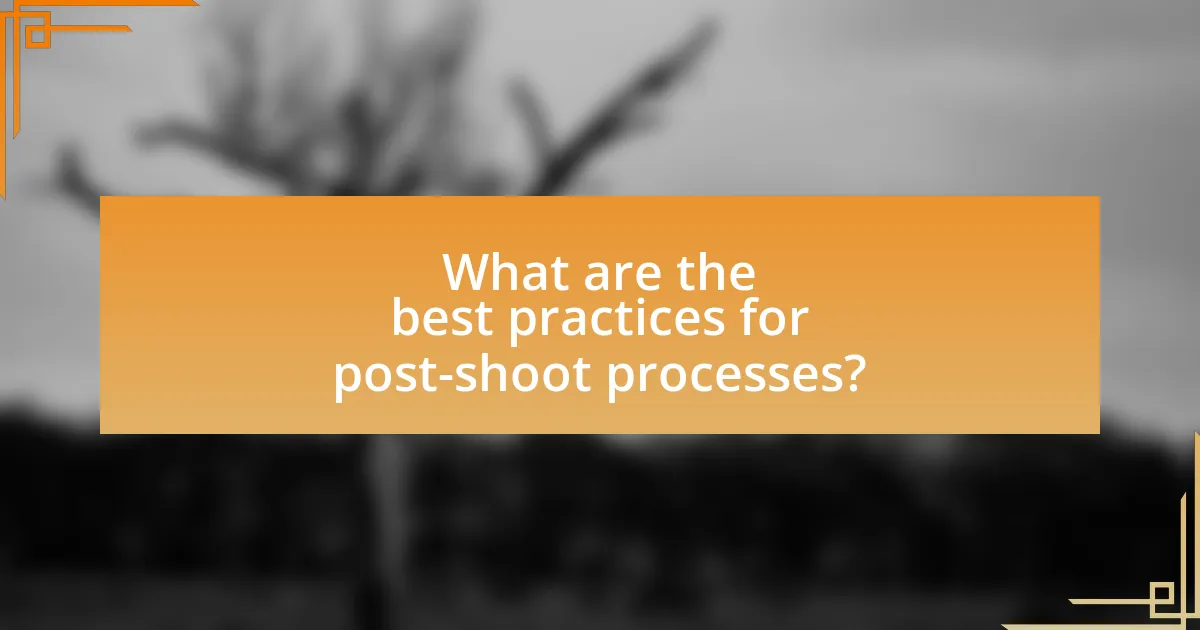The article focuses on the essential steps involved in preparing for a celebrity portrait shoot, providing a comprehensive checklist for photographers. Key topics include pre-shoot planning, location scouting, equipment preparation, and defining the shoot’s goals to capture the subject’s personality effectively. It emphasizes the importance of communication, rapport-building with the celebrity, and selecting appropriate lighting and poses to enhance the final images. Additionally, the article addresses post-shoot processes, including image selection and editing, as well as strategies for delivering high-quality portraits while managing common challenges that may arise during the shoot.

What is involved in preparing for a celebrity portrait shoot?
Preparing for a celebrity portrait shoot involves several key steps, including pre-shoot planning, location scouting, and equipment preparation. Pre-shoot planning requires thorough research on the celebrity’s style and preferences to create a tailored approach. Location scouting is essential to identify suitable backdrops that align with the desired aesthetic, ensuring the environment complements the subject. Equipment preparation includes selecting the appropriate camera gear, lighting, and props to achieve the desired visual outcome. These steps are critical as they enhance the overall quality and effectiveness of the portrait, leading to a successful shoot.
How do you define the goals of the portrait shoot?
The goals of a portrait shoot are defined by the desired outcome, which typically includes capturing the subject’s personality, conveying a specific mood, and highlighting their unique features. These goals guide the photographer in selecting appropriate settings, lighting, and poses that align with the intended message of the portrait. For instance, a celebrity portrait may aim to project glamour and sophistication, necessitating a high-fashion approach, while a more candid portrait might focus on authenticity and relatability.
What specific outcomes do you want to achieve with the shoot?
The specific outcomes to achieve with the shoot include capturing high-quality, visually compelling portraits that reflect the celebrity’s personality and brand. This involves utilizing appropriate lighting, angles, and settings to enhance the subject’s features and convey their unique story. Achieving these outcomes is supported by the fact that professional portrait photography often results in increased engagement and visibility for the subject, as evidenced by studies showing that high-quality images can boost social media interactions by up to 120%.
How do the goals influence your planning process?
Goals significantly influence the planning process by providing a clear direction and focus for the shoot. When a photographer establishes specific objectives, such as capturing a particular mood or highlighting the celebrity’s personality, it shapes decisions regarding location, lighting, and composition. For instance, if the goal is to convey elegance, the photographer may choose a sophisticated backdrop and soft lighting to enhance that theme. This targeted approach ensures that all elements of the shoot align with the desired outcome, ultimately leading to a more cohesive and impactful final product.
What are the essential pre-shoot preparations?
Essential pre-shoot preparations include thorough planning, equipment checks, and location scouting. Photographers must create a detailed shot list to ensure all desired images are captured, which helps streamline the shooting process. Equipment checks involve verifying that cameras, lenses, lighting, and backup gear are in optimal working condition to avoid technical issues during the shoot. Location scouting allows photographers to identify the best settings and lighting conditions, ensuring that the environment complements the subject. These steps are crucial for a successful celebrity portrait shoot, as they minimize potential disruptions and enhance the overall quality of the images.
How do you select the right location for the shoot?
To select the right location for the shoot, assess the subject’s personality and the desired mood of the portrait. The location should complement the celebrity’s image and the story you want to convey through the photograph. For instance, an urban setting may suit a contemporary artist, while a natural landscape might be ideal for an actor known for their environmental advocacy. Additionally, consider practical factors such as lighting, accessibility, and permits required for shooting in public spaces. Research shows that locations with natural light can enhance the quality of portraits, as noted in studies on photography techniques.
What equipment should you prepare in advance?
For a celebrity portrait shoot, you should prepare a camera, lenses, lighting equipment, and backup gear in advance. The camera should be capable of high-resolution images, while lenses should include a variety of focal lengths, such as a 50mm for portraits and a wide-angle lens for environmental shots. Lighting equipment, including softboxes or reflectors, is essential to achieve flattering illumination. Additionally, having backup gear, such as extra batteries, memory cards, and a second camera body, ensures that you are prepared for any unforeseen issues during the shoot. This preparation is crucial as it allows for a smooth workflow and minimizes the risk of technical failures that could disrupt the session.
How do you plan the shoot schedule effectively?
To plan the shoot schedule effectively, start by defining the key elements such as the location, duration, and availability of the celebrity. Establish a timeline that includes pre-shoot preparations, the shoot itself, and post-shoot activities. For instance, allocate specific time slots for makeup, wardrobe changes, and breaks to ensure a smooth workflow. Research indicates that a well-structured schedule can enhance productivity by up to 30%, allowing for better time management and reduced stress during the shoot.
What role does communication play in the preparation process?
Communication is essential in the preparation process for a celebrity portrait shoot as it ensures clarity and alignment between the photographer and the subject. Effective communication facilitates the sharing of expectations, preferences, and logistical details, which are crucial for a successful shoot. For instance, discussing the desired style, location, and timing allows both parties to prepare adequately, reducing the likelihood of misunderstandings. Research indicates that clear communication can enhance collaboration and creativity, leading to more satisfactory outcomes in photography projects.
How do you establish rapport with the celebrity?
To establish rapport with a celebrity, a photographer should engage in genuine conversation and show authentic interest in the celebrity’s work and personality. This approach fosters a comfortable environment, allowing the celebrity to feel valued and respected. Research indicates that building rapport can significantly enhance collaboration and trust, which are crucial for capturing authentic portraits. For instance, a study published in the Journal of Nonverbal Behavior highlights that positive interpersonal interactions lead to increased cooperation and openness, essential elements in a successful portrait shoot.
What information should you gather from the celebrity beforehand?
Gather the celebrity’s preferences regarding style, location, and mood for the portrait shoot. Understanding these elements ensures that the final images align with the celebrity’s vision and public persona. Additionally, collect information about any specific themes or concepts the celebrity wishes to explore, as well as their availability and any logistical considerations, such as travel or security requirements. This preparation facilitates a smoother shooting process and enhances the overall quality of the portraits.

What specific techniques enhance celebrity portrait shoots?
Specific techniques that enhance celebrity portrait shoots include utilizing natural light, employing creative angles, and incorporating personal elements that reflect the celebrity’s personality. Natural light can create a soft, flattering effect, while creative angles can add depth and interest to the composition. Additionally, integrating personal items or settings can help convey the subject’s character, making the portrait more engaging. These techniques are supported by the fact that many professional photographers emphasize the importance of authenticity and connection in portraiture, as seen in works by renowned photographers like Annie Leibovitz, who often captures subjects in meaningful contexts.
How do lighting techniques impact the final portrait?
Lighting techniques significantly impact the final portrait by influencing mood, depth, and the subject’s features. Different lighting setups, such as Rembrandt, butterfly, or split lighting, create distinct effects; for instance, Rembrandt lighting adds drama and dimension by casting shadows that enhance facial contours. Studies show that the direction, quality, and color of light can alter perceptions of beauty and emotion in portraits, with soft light often being more flattering and harsh light emphasizing imperfections. Therefore, the choice of lighting directly affects the viewer’s emotional response and the overall aesthetic of the portrait.
What types of lighting setups are most effective for portraits?
The most effective lighting setups for portraits include softbox lighting, umbrella lighting, and natural light. Softbox lighting provides a diffused and even illumination, reducing harsh shadows, which is ideal for flattering skin tones. Umbrella lighting reflects light and can create a soft, broad light source, enhancing the subject’s features. Natural light, particularly during golden hour, offers a warm and soft quality that can enhance the overall aesthetic of the portrait. These setups are widely used by professional photographers to achieve high-quality results in portrait photography.
How can you manipulate natural light for better results?
To manipulate natural light for better results, photographers can use reflectors, diffusers, and strategic positioning. Reflectors bounce light onto the subject, enhancing illumination and reducing shadows, while diffusers soften harsh sunlight, creating a more flattering effect. Positioning the subject in relation to the light source, such as using backlighting for a halo effect or side lighting for depth, can significantly improve the overall quality of the portrait. Studies show that utilizing these techniques can enhance the aesthetic appeal of photographs, making them more visually engaging.
What poses work best for celebrity portraits?
Dynamic poses that convey personality and emotion work best for celebrity portraits. These include candid shots that capture the subject in action, relaxed stances that showcase their natural demeanor, and classic poses that highlight their features, such as the three-quarter turn or head tilt. Research indicates that engaging poses can enhance the viewer’s connection to the subject, making the portrait more impactful. For instance, a study published in the Journal of Visual Communication found that portraits with expressive poses elicit stronger emotional responses from viewers, reinforcing the effectiveness of dynamic and authentic poses in celebrity photography.
How do you guide the celebrity into natural poses?
To guide the celebrity into natural poses, establish a comfortable environment and engage in casual conversation to ease any tension. This approach allows the celebrity to relax, making it easier for them to adopt spontaneous and authentic poses. Research indicates that relaxed subjects are more likely to exhibit natural body language and expressions, which enhances the overall quality of the portrait.
What are some common posing mistakes to avoid?
Common posing mistakes to avoid include poor posture, lack of engagement with the camera, and awkward hand placement. Poor posture, such as slouching or leaning too far forward, can create unflattering angles and diminish the subject’s presence in the portrait. Lack of engagement, where the subject appears disconnected or uninterested, can result in lifeless images. Additionally, awkward hand placement, such as having hands too stiff or in unnatural positions, can detract from the overall composition. These mistakes can significantly impact the quality of the portrait, making it essential for photographers to guide their subjects effectively to achieve the best results.
How can you incorporate props and backgrounds effectively?
Incorporating props and backgrounds effectively involves selecting elements that enhance the subject’s personality and story. Photographers should choose props that resonate with the celebrity’s interests or career, such as musical instruments for musicians or sports equipment for athletes, to create a more authentic representation. Backgrounds should complement the props and the subject, ensuring they do not distract from the main focus. For instance, using a simple, neutral backdrop can help highlight the subject and props without overwhelming the composition. Research indicates that thoughtful integration of props and backgrounds can significantly enhance visual storytelling in portrait photography, making the images more engaging and relatable.
What types of props enhance the portrait’s narrative?
Props that enhance a portrait’s narrative include personal items, symbolic objects, and contextual elements. Personal items, such as a favorite book or instrument, provide insight into the subject’s personality and interests. Symbolic objects, like awards or cultural artifacts, can convey achievements or heritage, adding depth to the story being told through the portrait. Contextual elements, such as specific locations or settings relevant to the subject’s life, further enrich the narrative by situating the subject within a meaningful environment. These types of props collectively contribute to a more engaging and informative portrayal, allowing viewers to connect with the subject on a deeper level.
How do you choose backgrounds that complement the subject?
To choose backgrounds that complement the subject, assess the subject’s characteristics, such as color, texture, and mood. A background should enhance these attributes without overwhelming them. For example, if the subject has vibrant clothing, a neutral or muted background can help them stand out. Conversely, if the subject’s attire is subdued, a more dynamic background can add interest. Research indicates that backgrounds with similar color palettes to the subject create harmony, while contrasting colors can evoke a sense of drama. This approach is supported by color theory, which shows that complementary colors enhance visual appeal.

What are the best practices for post-shoot processes?
The best practices for post-shoot processes include organizing and backing up images, conducting a thorough review and selection of the best shots, and performing necessary edits to enhance the final output. Organizing images involves categorizing them by date or subject, which facilitates easy access and retrieval. Backing up images is crucial; using multiple storage solutions, such as external hard drives and cloud services, ensures data safety. Reviewing and selecting the best shots allows photographers to focus on quality over quantity, often utilizing software tools for efficient culling. Editing should include adjustments to exposure, color correction, and retouching to meet professional standards. These practices are essential for maintaining workflow efficiency and ensuring high-quality results in photography.
How do you handle image selection and editing?
I handle image selection and editing by first reviewing all captured images to identify the best shots based on composition, lighting, and expression. This process involves using software tools like Adobe Lightroom or Photoshop to enhance selected images, adjusting parameters such as exposure, contrast, and color balance to achieve a polished final product. Research indicates that professional photographers often utilize a systematic approach to image curation, which can significantly improve the quality of the final output, as seen in studies highlighting the importance of post-processing in photography.
What criteria should you use for selecting the best images?
To select the best images, prioritize clarity, composition, and emotional impact. Clarity ensures that the subject is in focus and well-lit, which is essential for professional photography. Composition involves the arrangement of elements within the frame, adhering to principles like the rule of thirds, leading lines, and balance to create visually appealing images. Emotional impact refers to the ability of the image to convey a story or evoke feelings, which is particularly important in celebrity portraiture where connection with the audience is key. These criteria are validated by industry standards that emphasize the importance of technical quality and artistic expression in photography.
How do you approach the editing process for celebrity portraits?
I approach the editing process for celebrity portraits by first ensuring accurate color correction and exposure adjustments to maintain the subject’s natural appearance. This involves using software tools to enhance skin tones and correct lighting discrepancies while preserving the integrity of the original image. Additionally, I focus on retouching to remove any blemishes or distractions, ensuring the final image reflects the celebrity’s best features without appearing overly processed. This method aligns with industry standards, as professional photographers often emphasize the importance of authenticity in celebrity imagery, which is supported by practices outlined in resources like “The Art of Photography” by Bruce Barnbaum.
What strategies can you use for delivering the final images?
To deliver final images effectively, utilize digital platforms for quick sharing, such as cloud storage services like Dropbox or Google Drive. These platforms allow for high-resolution file transfers and easy access for clients. Additionally, consider creating a personalized online gallery using services like Pixieset, which provides a professional presentation and allows clients to download images directly. Implementing a clear timeline for delivery, such as within two weeks post-shoot, ensures client expectations are met. Providing a mix of formats, including JPEG for general use and TIFF for high-quality prints, caters to diverse client needs.
How do you present the images to the celebrity?
To present the images to the celebrity, a photographer should utilize a professional and respectful approach, ensuring that the images are displayed in a high-quality format, such as a digital slideshow or printed portfolio. This method allows the celebrity to view the images clearly and appreciate the details captured during the shoot. Presenting the images in a well-organized manner, perhaps categorizing them by theme or style, enhances the viewing experience and facilitates discussion about the images. This approach is validated by industry standards, where effective image presentation is crucial for client satisfaction and engagement in professional photography.
What are the best formats for delivering final portraits?
The best formats for delivering final portraits are high-resolution digital files, prints, and albums. High-resolution digital files allow for versatile use across various platforms, ensuring quality retention for both online and print applications. Prints provide a tangible product that can be displayed or gifted, while albums offer a curated collection that enhances the storytelling aspect of the portraits. Each format caters to different client preferences and usage scenarios, making them essential for comprehensive delivery.
What common challenges might arise during a celebrity portrait shoot?
Common challenges during a celebrity portrait shoot include time constraints, the celebrity’s mood, and logistical issues. Time constraints often arise due to the celebrity’s busy schedule, limiting the duration available for the shoot. The celebrity’s mood can significantly impact the shoot’s outcome, as stress or discomfort may affect their willingness to engage with the camera. Logistical issues, such as location permits or equipment malfunctions, can also disrupt the planned shoot. These challenges are frequently reported by photographers in industry discussions, highlighting the need for thorough preparation and adaptability.
How can you troubleshoot unexpected issues during the shoot?
To troubleshoot unexpected issues during a shoot, immediately assess the situation to identify the specific problem, whether it’s technical, environmental, or related to the subject. For example, if lighting is inadequate, adjust the settings on your camera or reposition the lights to achieve the desired effect. If the subject is uncomfortable, communicate openly to understand their needs and make adjustments to create a more relaxed atmosphere. Additionally, having backup equipment, such as extra batteries and lenses, can mitigate technical failures. According to a study by the American Society of Media Photographers, 70% of photographers report that preparation and adaptability are key to resolving issues effectively during shoots.
What are some tips for managing time effectively during the session?
To manage time effectively during a celebrity portrait shoot session, prioritize creating a detailed schedule that allocates specific time slots for each segment of the shoot, including setup, shooting, and breaks. This structured approach ensures that all necessary tasks are completed within the allotted time, minimizing delays. Additionally, using a timer can help keep track of each segment, allowing for adjustments as needed. Research indicates that effective time management can increase productivity by up to 25%, highlighting the importance of planning and adherence to a schedule in achieving successful outcomes during photography sessions.



